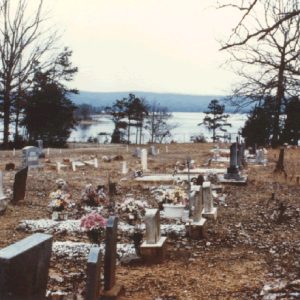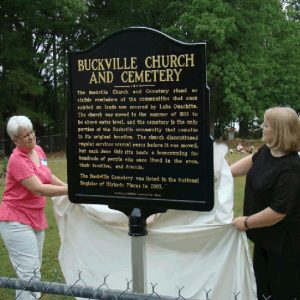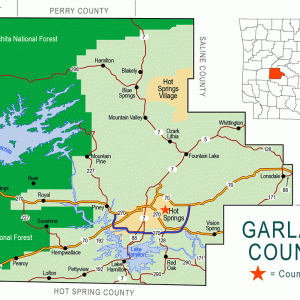calsfoundation@cals.org
Buckville (Garland County)
The community of Buckville, located on the upper Ouachita River in Garland County, emerged as a small town amidst the sparsely settled Ouachita Mountains after the Civil War. The town typified rural upland Arkansas with its small farms and reliance on agriculture. Following the construction of Blakely Mountain Dam in the 1950s, the waters of Lake Ouachita covered the site of Buckville. The lake’s completion necessitated a total, permanent evacuation of the town.
Extensive archaeological remains exist in the upper Ouachita River valley; many fields bordering on the river contain evidence of Native American presence in the area. Caddo occupied the Ouachita Mountains in relatively small, widely dispersed settlements in the northern part of the region. By 1700, no European or Indian resident communities remained, although the area hosted numerous transient populations until the time of permanent American settlement.
Small subsistence farms dominated the upper Ouachita River valley up until the time of the Civil War. The war brought great disruption to the area—both armies foraged and skirmished there, and bands of irregulars terrorized the population. After the war, the community of Buckville came into being, and by 1891, Goodspeed’s Biographical and Historical Memoirs of Western Arkansas called it a “flourishing little town” with an estimated population of 100. A post office had been established in 1884, and by 1900, the hamlet included a general store, a gin, a grist mill, and two physicians, in addition to a blacksmith, lawyer, and druggist.
While the various businesses served the citizenry, the area’s small farms typified rural upland Arkansas. Residents established schools, as well as Baptist and Methodist churches. The White Plains Baptist Church, located one mile west of Buckville, was constituted in 1884, and the Buckville Baptist Church began holding services in the 1880s as well. The Buckville School, which began classes in the mid-1880s and included grades one through eight, was the area’s largest school; most Buckville students graduated from high school at either Mount Ida (Montgomery County) or Hot Springs (Garland County). Local branches of fraternal organizations sprang up in and around Buckville, such as the Buckville Lodge I.O.O.F. (International Order of the Odd Fellows) organized in 1904.
In the twentieth century, small farms supported the majority of the population. Modernization never came to Buckville. Paved roads; bridges; and water, sewer, and electrical service never made it to the area, although some residents enjoyed sporadic use of a local battery-powered electric system, which illuminated a few street lights. Outside communication was through a telephone exchange that connected Buckville and Cedar Glades (Garland County), with a line eventually extending to Hot Springs.
After 1920, outside forces brought major disruption to the region, beginning a dislocation of the area’s population. Following the completion of the Remmel and Carpenter dams by Arkansas Power and Light (AP&L) near Hot Springs in the late 1920s, construction of another similar but larger facility at Blakely Mountain loomed on the horizon. As the project moved forward, AP&L and the Dierks company began land and timber acquisition programs in the proposed reservoir area. After World War II, when the federal government’s U.S. Army Corps of Engineers assumed control of the dam construction project, even more land was acquired. An exodus from the area began in the 1920s and culminated in the early 1950s with the completion of Blakely Mountain Dam and subsequent filling of Lake Ouachita.
Since the dam’s construction seemed imminent, residents made virtually no changes to Buckville’s physical landscape from the 1920s until the time that homes and businesses began to be dismantled or demolished. By 1947, almost all of the buildings in the area had been torn down. Schools closed, and organizations disbanded or moved. Timber was cut from 1951 to 1953. Land was cleared, but some brush was left for fish cover and spawning grounds in the new lake. Graves were moved to new locations in 1951, when contractors transported remains from the reservoir area to existing cemeteries as well as several sites established for the specific purpose of accommodating graves.
The White Plains Baptist Church disbanded in 1930. Significantly, the Buckville Baptist Church’s congregation chose not to allow its building to be demolished. Members made plans in 1950 to move the structure to a nearby location at the same time the church voted to discontinue services.
With few residents left to serve, postal service in the area gradually ended. The Avant Post Office closed at the end of 1937, and the point of service shifted to Buckville. Ironically, in 1951 the Buckville Post Office moved its operation to Avant (Garland County), where it continued for several decades as a “community post office” of Hot Springs. This change proved to be a source of confusion to outsiders for years.
Blakely Mountain Dam was dedicated on July 4, 1956. The reservoir created by the dam, Lake Ouachita, extends thirty-four miles upstream and covers more than 48,000 acres of land, including the former location of Buckville.
Today, the Buckville Baptist Church and Cemetery serve as visual links to town’s past, since only the church and cemetery exist as tangible reminders of the former community. The church was moved in the summer of 1951 to be above water level, but the adjacent cemetery remains in its original location. Both now stand on the northern shore of Lake Ouachita. As the only remnant of the community not relocated, the cemetery was listed on the National Register of Historic Places in 2007. Each June, the church and cemetery site hosts a reunion for hundreds of people who once lived in Buckville, Cedar Glades, and other communities within the now-inundated area.
For additional information:
Biographical and Historical Memoirs of Western Arkansas. Chicago: Goodspeed Publishing Company, 1891.
“Buckville.” Subject file. Garland County Historical Society Archives, Hot Springs, Arkansas.
Richter, Wendy. “‘Swallowed Up in One Gulp’: Lost Communities of the Upper Ouachita River Valley.”PhD diss., Arkansas State University, 2005.
Richter, Wendy Bradley, and Inez E. Cline. They Can’t Go Home: A History of Northwestern Garland County, Arkansas. N.p: 1990.
Richter, Wendy. “The Impact of Blakely Mountain Dam on Northwestern Garland County.” The Record 43 (2002): 1–11.
———. “Ordinary Communities, Extraordinary Experiences: A Garland County Exodus.” The Record 61 (2020): 2.1–2.24.
Wendy Richter
Ouachita Baptist University
 Buckville Cemetery
Buckville Cemetery  Buckville Cemetery Marker
Buckville Cemetery Marker  Garland County Map
Garland County Map 




Comments
No comments on this entry yet.